道路条件交通安全英文文献翻译
交通安全英语作文带翻译
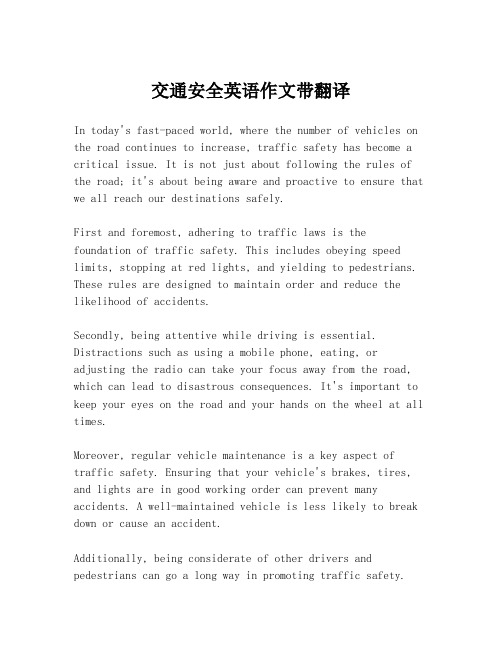
交通安全英语作文带翻译In today's fast-paced world, where the number of vehicles on the road continues to increase, traffic safety has become a critical issue. It is not just about following the rules of the road; it's about being aware and proactive to ensure that we all reach our destinations safely.First and foremost, adhering to traffic laws is the foundation of traffic safety. This includes obeying speed limits, stopping at red lights, and yielding to pedestrians. These rules are designed to maintain order and reduce the likelihood of accidents.Secondly, being attentive while driving is essential. Distractions such as using a mobile phone, eating, or adjusting the radio can take your focus away from the road, which can lead to disastrous consequences. It's important to keep your eyes on the road and your hands on the wheel at all times.Moreover, regular vehicle maintenance is a key aspect of traffic safety. Ensuring that your vehicle's brakes, tires, and lights are in good working order can prevent many accidents. A well-maintained vehicle is less likely to break down or cause an accident.Additionally, being considerate of other drivers and pedestrians can go a long way in promoting traffic safety.This means not only following the rules but also showing courtesy, such as using your turn signals and not honking unnecessarily.Lastly, educating oneself and others about traffic safety is vital. Understanding the potential dangers and how to avoid them can save lives. Many communities offer traffic safety courses that can provide valuable information and skills.In conclusion, traffic safety is a shared responsibility that requires vigilance, respect, and education from all road users. By working together, we can create safer roads for everyone.在当今快节奏的世界中,道路上的车辆数量持续增加,交通安全已成为一个关键问题。
交通安全英语作文 带翻译
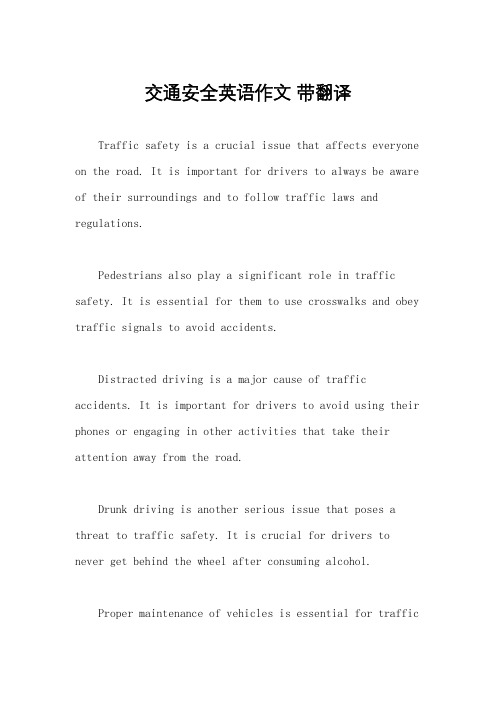
交通安全英语作文带翻译Traffic safety is a crucial issue that affects everyone on the road. It is important for drivers to always be aware of their surroundings and to follow traffic laws and regulations.Pedestrians also play a significant role in traffic safety. It is essential for them to use crosswalks and obey traffic signals to avoid accidents.Distracted driving is a major cause of traffic accidents. It is important for drivers to avoid using their phones or engaging in other activities that take their attention away from the road.Drunk driving is another serious issue that poses a threat to traffic safety. It is crucial for drivers to never get behind the wheel after consuming alcohol.Proper maintenance of vehicles is essential for trafficsafety. It is important for drivers to regularly check their brakes, tires, and lights to ensure that their vehicles are in good working condition.Speeding is a common cause of traffic accidents. It is important for drivers to obey speed limits and to adjust their speed according to road and weather conditions.In conclusion, traffic safety is a responsibility that falls on everyone on the road. By following traffic laws, avoiding distractions, and maintaining vehicles properly, we can all contribute to making the roads safer for everyone. Thank you.。
交通安全的英语作文带翻译
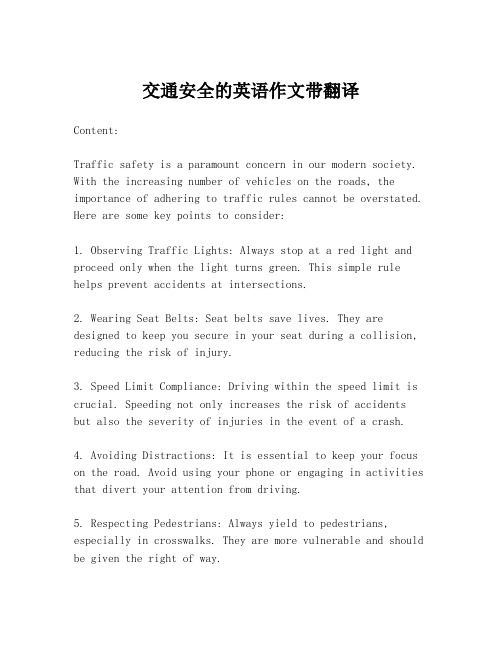
交通安全的英语作文带翻译Content:Traffic safety is a paramount concern in our modern society. With the increasing number of vehicles on the roads, the importance of adhering to traffic rules cannot be overstated. Here are some key points to consider:1. Observing Traffic Lights: Always stop at a red light and proceed only when the light turns green. This simple rule helps prevent accidents at intersections.2. Wearing Seat Belts: Seat belts save lives. They are designed to keep you secure in your seat during a collision, reducing the risk of injury.3. Speed Limit Compliance: Driving within the speed limit is crucial. Speeding not only increases the risk of accidents but also the severity of injuries in the event of a crash.4. Avoiding Distractions: It is essential to keep your focus on the road. Avoid using your phone or engaging in activities that divert your attention from driving.5. Respecting Pedestrians: Always yield to pedestrians, especially in crosswalks. They are more vulnerable and should be given the right of way.6. Regular Vehicle Maintenance: Keeping your vehicle in good condition is essential. Regular maintenance checks canprevent mechanical failures that could lead to accidents.7. Driving Under the Influence: Never drive under theinfluence of alcohol or drugs. It impairs your judgment and reaction time, significantly increasing the risk of accidents.8. Being Prepared for Weather Conditions: Adjust your driving according to the weather. Slow down in rain or snow and increase your following distance to avoid skidding.9. Education and Awareness: Continuously educate yourself on traffic laws and safety measures. Awareness campaigns and driver's education can help reinforce good driving habits.10. Promoting a Culture of Safety: Encourage others to follow traffic rules and be a role model for safe driving practices.By following these guidelines, we can contribute to a safer driving environment for everyone on the road.内容:交通安全是我们现代社会中极为重要的问题。
交通安全英语作文带翻译

交通安全英语作文带翻译In our daily lives, traffic safety is a crucial aspect that we cannot afford to ignore. With the increasing number of vehicles on the road, the risk of accidents also rises. Therefore, it is imperative that we understand and adhere to traffic rules to ensure our safety and the safety of others.Firstly, obeying traffic signals is fundamental. Red means stop, yellow means prepare to stop, and green means go. These signals are designed to control the flow of traffic and prevent accidents. It is our responsibility to follow them diligently.Secondly, wearing a seatbelt is a simple yet effective way to protect ourselves in the event of a crash. Seatbelts significantly reduce the risk of injury and death by restraining passengers and preventing them from being thrown from the vehicle.Thirdly, avoiding distractions while driving is essential. This includes not using a mobile phone, not eating, and not engaging in any activities that take your eyes off the road. Distractions can lead to a lack of focus and increase the likelihood of an accident.Lastly, being aware of your surroundings is vital. Always check your mirrors and blind spots before changing lanes or making turns. This helps you to anticipate the actions ofother drivers and react accordingly.In conclusion, traffic safety is a shared responsibility. By following these simple rules, we can contribute to a safer driving environment for everyone. Let us all commit to being responsible drivers and pedestrians.在我们的日常生活中,交通安全是一个我们不能忽视的重要方面。
交通安全的英语作文带翻译
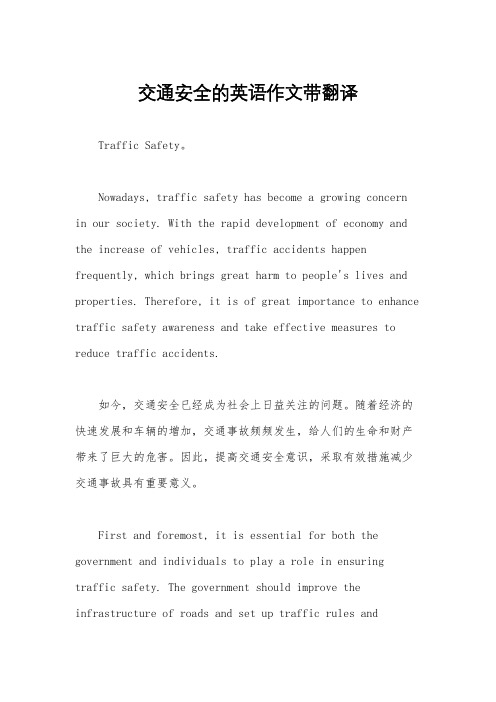
交通安全的英语作文带翻译Traffic Safety。
Nowadays, traffic safety has become a growing concernin our society. With the rapid development of economy and the increase of vehicles, traffic accidents happen frequently, which brings great harm to people's lives and properties. Therefore, it is of great importance to enhance traffic safety awareness and take effective measures to reduce traffic accidents.如今,交通安全已经成为社会上日益关注的问题。
随着经济的快速发展和车辆的增加,交通事故频频发生,给人们的生命和财产带来了巨大的危害。
因此,提高交通安全意识,采取有效措施减少交通事故具有重要意义。
First and foremost, it is essential for both the government and individuals to play a role in ensuringtraffic safety. The government should improve the infrastructure of roads and set up traffic rules andregulations to regulate the traffic order. Meanwhile, individuals should abide by traffic rules, drive carefully and responsibly, and never drink and drive. Moreover, it is necessary to raise public awareness of traffic safety through various channels such as education, publicity campaigns, and media coverage.首先,政府和个人在确保交通安全方面发挥着至关重要的作用。
交通安全外文翻译文献中英文

外文文献翻译(含:英文原文及中文译文)英文原文POSSIBILITIES AND LIMITA TIONS OF ACCIDENT ANALYSISS.OppeAbstraetAccident statistics, especially collected at a national level are particularly useful for the description, monitoring and prognosis of accident developments, the detection of positive and negative safety developments, the definition of safety targets and the (product) evaluation of long term and large scale safety measures. The application of accident analysis is strongly limited for problem analysis, prospective and retrospective safety analysis on newly developed traffic systems or safety measures, as well as for (process) evaluation of special short term and small scale safety measures. There is an urgent need for the analysis of accidents in real time, in combination with background behavioural research. Automatic incident detection, combined with video recording of accidents may soon result in financially acceptable research. This type of research may eventually lead to a better understanding of the concept of risk in traffic and to well-established theories.Keyword: Consequences; purposes; describe; Limitations; concerned; Accident Analysis; possibilities1. Introduction.This paper is primarily based on personal experience concerning traffic safety, safety research and the role of accidents analysis in this research. These experiences resulted in rather philosophical opinions as well as more practical viewpoints on research methodology and statistical analysis. A number of these findings are published already elsewhere.From this lack of direct observation of accidents, a number of methodological problems arise, leading to continuous discussions about the interpretation of findings that cannot be tested directly. For a fruitful discussion of these methodological problems it is very informative to look at a real accident on video. It then turns out that most of the relevant information used to explain the accident will be missing in the accident record. In-depth studies also cannot recollect all the data that is necessary in order to test hypotheses about the occurrence of the accident. For a particular car-car accident, that was recorded on video at an urban intersection in the Netherlands, between a car coming from a minor road, colliding with a car on the major road, the following questions could be asked: Why did the driver of the car coming from the minor road, suddenly accelerate after coming almost to a stop and hit the side of the car from the left at the main road? Why was the approaching car not noticed? Was it because the driver was preoccupied with the two cars coming from the right and the gap before them that offered him thepossibility to cross? Did he look left before, but was his view possibly blocked by the green van parked at the corner? Certainly the traffic situation was not complicated. At the moment of the accident there were no bicyclists or pedestrians present to distract his attention at the regularly overcrowded intersection. The parked green van disappeared within five minutes, the two other cars that may have been important left without a trace. It is hardly possible to observe traffic behavior under the most relevant condition of an accident occurring, because accidents are very rare events, given the large number of trips. Given the new video equipment and the recent developments in automatic incident and accident detection, it becomes more and more realistic to collect such data at not too high costs. Additional to this type of data that is most essential for a good understanding of the risk increasing factors in traffic, it also important to look at normal traffic behavior as a reference base. The question about the possibilities and limitations of accident analysis is not lightly answered. We cannot speak unambiguously about accident analysis. Accident analysis covers a whole range of activities, each originating from a different background and based on different sources of information: national data banks, additional information from other sources, especially collected accident data, behavioral background data etc. To answer the question about the possibilities and limitations, we first have to look at the cycle of activities in the area of traffic safety. Some ofthese activities are mainly concerned with the safety management of the traffic system; some others are primarily research activities.The following steps should be distinguished:- detection of new or remaining safety problems;- description of the problem and its main characteristics;- the analysis of the problem, its causes and suggestions for improvement;- selection and implementation of safety measures;- evaluation of measures taken.Although this cycle can be carried out by the same person or group of persons, the problem has a different (political/managerial or scientific) background at each stage. We will describe the phases in which accident analysis is used. It is important to make this distinction. Many fruitless discussions about the method of analysis result from ignoring this distinction. Politicians, or road managers are not primarily interested in individual accidents. From their perspective accidents are often treated equally, because the total outcome is much more important than the whole chain of events leading to each individual accident. Therefore, each accident counts as one and they add up all together to a final safety result.Researchers are much more interested in the chain of events leading to an individual accident. They want to get detailed information abouteach accident, to detect its causes and the relevant conditions. The politician wants only those details that direct his actions. At the highest level this is the decrease in the total number of accidents. The main source of information is the national database and its statistical treatment. For him, accident analysis is looking at (subgroups of) accident numbers and their statistical fluctuations. This is the main stream of accident analysis as applied in the area of traffic safety. Therefore, we will first describe these aspects of accidents.2. The nature of accidents and their statistical characteristics.The basic notion is that accidents, whatever there cause, appear according to a chance process. Two simple assumptions are usually made to describe this process for (traffic) accidents:- the probability of an accident to occur is independent from the occurrence of previous accidents;-the occurrence of accidents is homogeneous in time.If these two assumptions hold, then accidents are Poisson distributed. The first assumption does not meet much criticism. Accidents are rare events and therefore not easily influenced by previous accidents. In some cases where there is a direct causal chain (e.g. , when a number of cars run into each other) the series of accidents may be regarded as one complicated accident with many cars involved.The assumption does not apply to casualties. Casualties are often related to the same accident andtherefore the independency assumption does not hold. The second assumption seems less obvious at first sight. The occurrence of accidents through time or on different locations are not equally likely. However, the assumption need not hold over long time periods. It is a rather theoretical assumption in its nature. If it holds for short periods of time, then it also holds for long periods, because the sum of Poisson distributed variables, even if their Poisson rates are different, is also Poisson distributed. The Poisson rate for the sum of these periods is then equal to the sum of the Poisson rates for these parts.The assumption that really counts for a comparison of (composite) situations, is whether two outcomes from an aggregation of situations in time and/or space, have a comparable mix of basic situations. E.g. , the comparison of the number of accidents on one particular day of the year, as compared to another day (the next day, or the same day of the next week etc.). If the conditions are assumed to be the same (same duration, same mix of traffic and situations, same weather conditions etc.) then the resulting numbers of accidents are the outcomes of the same Poisson process. This assumption can be tested by estimating the rate parameter on the basis of the two observed values (the estimate being the average of the two values). Probability theory can be used to compute the likelihood of the equality assumption, given the two observations and their mean.This statistical procedure is rather powerful. The Poisson assumptionis investigated many times and turns out to be supported by a vast body of empirical evidence. It has been applied in numerous situations to find out whether differences in observed numbers of accidents suggest real differences in safety. The main purpose of this procedure is to detect differences in safety. This may be a difference over time, or between different places or between different conditions. Such differences may guide the process of improvement. Because the main concern is to reduce the number of accidents, such an analysis may lead to the most promising areas for treatment. A necessary condition for the application of such a test is, that the numbers of accidents to be compared are large enough to show existing differences. In many local cases an application is not possible. Accident black-spot analysis is often hindered by this limitation, e.g., if such a test is applied to find out whether the number of accidents at a particular location is higher than average. The procedure described can also be used if the accidents are classified according to a number of characteristics to find promising safety targets. Not only with aggregation, but also with disaggregation the Poisson assumption holds, and the accident numbers can be tested against each other on the basis of the Poisson assumptions. Such a test is rather cumbersome, because for each particular case, i.e. for each different Poisson parameter, the probabilities for all possible outcomes must be computed to apply the test. In practice, this is not necessary when the numbers are large. Then the Poissondistribution can be approximated by a Normal distribution, with mean and variance equal to the Poisson parameter. Once the mean value and the variance of a Normal distribution are given, all tests can be rephrased in terms of the standard Normal distribution with zero mean and variance one. No computations are necessary any more, but test statistics can be drawn from tables.3. The use of accident statistics for traffic safety policy.The testing procedure described has its merits for those types of analysis that are based on the assumptions mentioned. The best example of such an application is the monitoring of safety for a country or region over a year, using the total number of accidents (eventually of a particular type, such as fatal accidents), in order to compare this number with the outcome of the year before. If sequences of accidents are given over several years, then trends in the developments can be detected and accident numbers predicted for following years. Once such a trend is established, then the value for the next year or years can be predicted, together with its error bounds. Deviations from a given trend can also be tested afterwards, and new actions planned. The most famous one is carried out by Smeed 1949. We will discuss this type of accident analysis in more detail later.(1). The application of the Chi-square test for interaction is generalised to higher order classifications. Foldvary and Lane (1974), inmeasuring the effect of compulsory wearing of seat belts, were among the first who applied the partitioning of the total Chi-square in values for the higher order interactions of four-way tables.(2). Tests are not restricted to overall effects, but Chi-square values can be decomposed regarding sub-hypotheses within the model. Also in the two-way table, the total Chisquare can be decomposed into interaction effects of part tables. The advantage of 1. and 2. over previous situations is, that large numbers of Chi-square tests on many interrelated (sub)tables and corresponding Chi-squares were replaced by one analysis with an exact portioning of one Chi-square.(3). More attention is put to parameter estimation. E.g., the partitioning of the Chi-square made it possible to test for linear or quadratic restraints on the row-parameters or for discontinuities in trends.(4). The unit of analysis is generalised from counts to weighted counts. This is especially advantageous for road safety analyses, where corrections for period of time, number of road users, number of locations or number of vehicle kilometres is often necessary. The last option is not found in many statistical packages. Andersen 1977 gives an example for road safety analysis in a two-way table. A computer programme WPM, developed for this type of analysis of multi-way tables, is available at SWOV (see: De Leeuw and Oppe 1976). The accident analysis at this level is not explanatory. It tries to detect safety problems that need specialattention. The basic information needed consists of accident numbers, to describe the total amount of unsafety, and exposure data to calculate risks and to find situations or (groups of) road users with a high level of risk. 4. Accident analysis for research purposes.Traffic safety research is concerned with the occurrence of accidents and their consequences. Therefore, one might say that the object of research is the accident. The researcher’s interest however is less focused at this final outcome itself, but much more at the process that results (or does not result) in accidents. Therefore, it is better to regard the critical event in traffic as his object of study. One of the major problems in the study of the traffic process that results in accidents is, that the actual occurrence is hardly ever observed by the researcher.Investigating a traffic accident, he will try to reconstruct the event from indirect sources such as the information given by the road users involved, or by eye-witnesses, about the circumstances, the characteristics of the vehicles, the road and the drivers. As such this is not unique in science, there are more examples of an indirect study of the object of research. However, a second difficulty is, that the object of research cannot be evoked. Systematic research by means of controlled experiments is only possible for aspects of the problem, not for the problem itself. The combination of indirect observation and lack of systematic control make it very difficult for the investigator to detectwhich factors, under what circumstances cause an accident. Although the researcher is primarily interested in the process leading to accidents, he has almost exclusively information about the consequences, the product of it, the accident. Furthermore, the context of accidents is complicated. Generally speaking, the following aspects can be distinguished: - Given the state of the traffic system, traffic volume and composition, the manoeuvres of the road users, their speeds, the weather conditions, the condition of the road, the vehicles, the road users and their interactions, accidents can or cannot be prevented.- Given an accident, also depending on a large number of factors, such as the speed and mass of vehicles, the collision angle, the protection of road users and their vulnerability, the location of impact etc., injuries are more or less severe or the material damage is more or less substantial. Although these aspects cannot be studied independently, from a theoretical point of view it has advantages to distinguish the number of situations in traffic that are potentially dangerous, from the probability of having an accident given such a potentially dangerous situation and also from the resulting outcome, given a particular accident.This conceptual framework is the general basis for the formulation of risk regarding the decisions of individual road users as well as the decisions of controllers at higher levels. In the mathematical formulation of risk we need an explicit description of our probability space, consistingof the elementary events (the situations) that may result in accidents, the probability for each type of event to end up in an accident, and finally the particular outcome, the loss, given that type of accident.A different approach is to look at combinations of accident characteristics, to find critical factors. This type of analysis may be carried out at the total group of accidents or at subgroups. The accident itself may be the unit of research, but also a road, a road location, a road design (e.g. a roundabout) etc.中文译文交通事故分析的可能性和局限性S.Oppe摘要交通事故的统计数字, 尤其国家一级的数据对监控和预测事故的发展, 积极或消极检测事故的发展, 以及对定义安全目标和评估工业安全特别有益。
交通安全英语作文 带翻译

Title:The Importance of Traffic SafetyContent:Traffic safety is a critical issue that affects everyones daily life.With the rapid development of the transportation sector,the number of vehicles on the roads has been increasing exponentially,leading to a higher risk of traffic accidents.Therefore,it is imperative to pay attention to traffic safety and take necessary precautions to ensure the safety of oneself and others.Translation:交通安全是一个影响每个人日常生活的关键问题。
随着交通部门的快速发展,道路上的车辆数量呈指数增长,导致交通事故风险增加。
因此,关注交通安全并采取必要的预防措施以确保自己和他人的安全至关重要。
Firstly,adhering to traffic rules is the foundation of traffic safety.Drivers must obey traffic signals,not exceed speed limits,and avoid driving under the influence of alcohol or drugs.Pedestrians should also follow traffic rules by not crossing the road when the signal is red and by using pedestrian crossings where available.翻译:首先,遵守交通规则是交通安全的基础。
道路交通安全毕业论文中英文资料外文翻
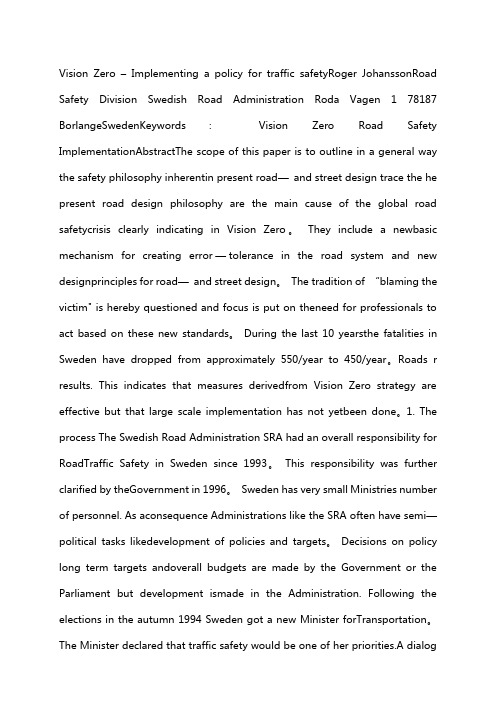
Vision Zero –Implementing a policy for traffic safetyRoger JohanssonRoad Safety Division Swedish Road Administration Roda Vagen 1 78187 BorlangeSwedenKeywords:Vision Zero Road Safety ImplementationAbstractThe scope of this paper is to outline in a general way the safety philosophy inherentin present road—and street design trace the he present road design philosophy are the main cause of the global road safetycrisis clearly indicating in Vision Zero。
They include a newbasic mechanism for creating error—tolerance in the road system and new designprinciples for road—and street design。
The tradition of “blaming the victim" is hereby questioned and focus is put on theneed for professionals to act based on these new standards。
During the last 10 yearsthe fatalities in Sweden have dropped from approximately 550/year to 450/year。
交通安全作文英语英汉互译
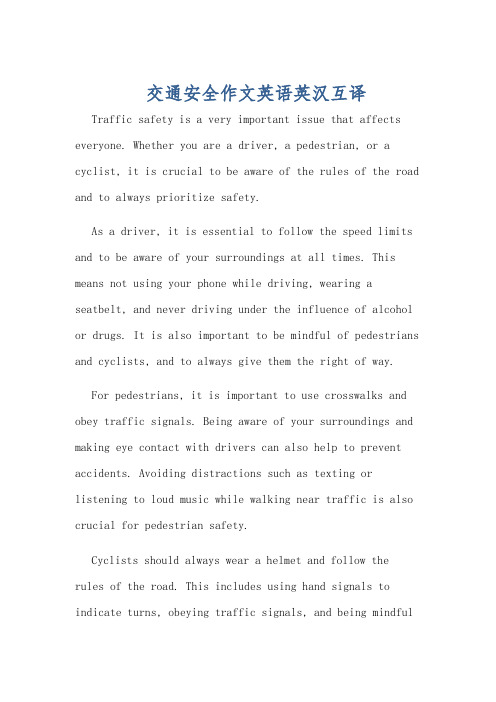
交通安全作文英语英汉互译Traffic safety is a very important issue that affects everyone. Whether you are a driver, a pedestrian, or a cyclist, it is crucial to be aware of the rules of the road and to always prioritize safety.As a driver, it is essential to follow the speed limits and to be aware of your surroundings at all times. This means not using your phone while driving, wearing a seatbelt, and never driving under the influence of alcohol or drugs. It is also important to be mindful of pedestrians and cyclists, and to always give them the right of way.For pedestrians, it is important to use crosswalks and obey traffic signals. Being aware of your surroundings and making eye contact with drivers can also help to prevent accidents. Avoiding distractions such as texting or listening to loud music while walking near traffic is also crucial for pedestrian safety.Cyclists should always wear a helmet and follow therules of the road. This includes using hand signals to indicate turns, obeying traffic signals, and being mindfulof vehicles and pedestrians. It is also important for cyclists to make themselves visible to drivers, especiallyat night, by using lights and reflective gear.Overall, traffic safety is a shared responsibility that requires everyone to be mindful and considerate of others. By following the rules of the road and prioritizing safety, we can all work together to prevent accidents and make the roads safer for everyone.交通安全是一个非常重要的问题,影响着每个人。
交通安全的英语作文带翻译
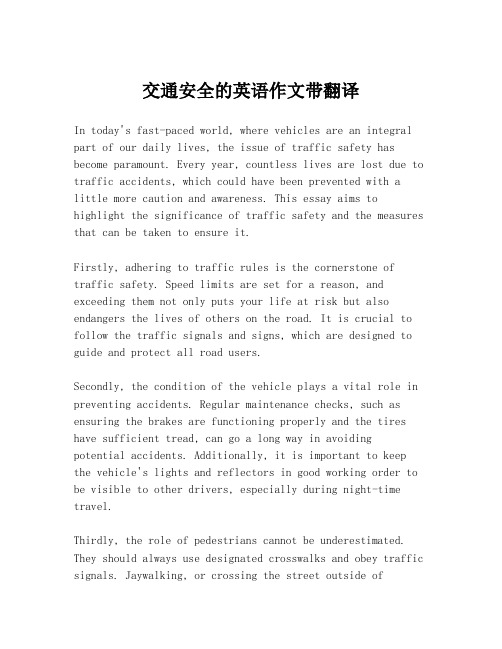
交通安全的英语作文带翻译In today's fast-paced world, where vehicles are an integral part of our daily lives, the issue of traffic safety has become paramount. Every year, countless lives are lost due to traffic accidents, which could have been prevented with a little more caution and awareness. This essay aims to highlight the significance of traffic safety and the measures that can be taken to ensure it.Firstly, adhering to traffic rules is the cornerstone of traffic safety. Speed limits are set for a reason, and exceeding them not only puts your life at risk but also endangers the lives of others on the road. It is crucial to follow the traffic signals and signs, which are designed to guide and protect all road users.Secondly, the condition of the vehicle plays a vital role in preventing accidents. Regular maintenance checks, such as ensuring the brakes are functioning properly and the tires have sufficient tread, can go a long way in avoidingpotential accidents. Additionally, it is important to keep the vehicle's lights and reflectors in good working order to be visible to other drivers, especially during night-time travel.Thirdly, the role of pedestrians cannot be underestimated. They should always use designated crosswalks and obey traffic signals. Jaywalking, or crossing the street outside ofdesignated areas, is a common cause of pedestrian accidents and should be avoided at all costs.Moreover, the influence of alcohol and drugs on driving is well-documented. Driving under the influence significantly impairs reaction times and judgment, leading to a higher likelihood of accidents. It is essential to avoid driving if you have consumed alcohol or taken drugs.Lastly, promoting traffic safety education in schools and communities is key to creating a culture of safe driving. By teaching children and adults about the rules of the road and the consequences of reckless driving, we can foster a society that values and practices traffic safety.In conclusion, traffic safety is a collective responsibility that requires the commitment of every individual. Byfollowing traffic rules, maintaining our vehicles, being mindful as pedestrians, avoiding driving under the influence, and educating ourselves and others, we can significantly reduce the number of traffic accidents and save lives.翻译:在当今快节奏的世界中,车辆已成为我们日常生活中不可或缺的一部分,交通安全问题因此变得至关重要。
交通安全英语作文
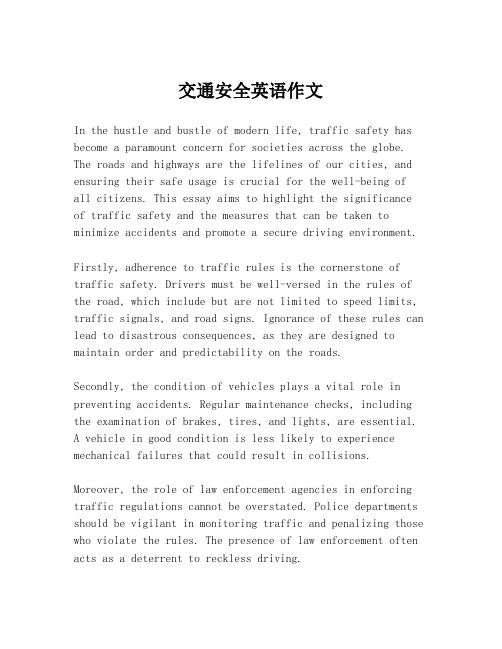
交通安全英语作文In the hustle and bustle of modern life, traffic safety has become a paramount concern for societies across the globe. The roads and highways are the lifelines of our cities, and ensuring their safe usage is crucial for the well-being ofall citizens. This essay aims to highlight the significance of traffic safety and the measures that can be taken to minimize accidents and promote a secure driving environment.Firstly, adherence to traffic rules is the cornerstone of traffic safety. Drivers must be well-versed in the rules of the road, which include but are not limited to speed limits, traffic signals, and road signs. Ignorance of these rules can lead to disastrous consequences, as they are designed to maintain order and predictability on the roads.Secondly, the condition of vehicles plays a vital role in preventing accidents. Regular maintenance checks, including the examination of brakes, tires, and lights, are essential.A vehicle in good condition is less likely to experience mechanical failures that could result in collisions.Moreover, the role of law enforcement agencies in enforcing traffic regulations cannot be overstated. Police departments should be vigilant in monitoring traffic and penalizing those who violate the rules. The presence of law enforcement often acts as a deterrent to reckless driving.Education and awareness campaigns are another key component in promoting traffic safety. Public service announcements, school programs, and community workshops can all contribute to raising awareness about the importance of safe driving practices. Education can empower individuals to make informed decisions when on the road.Additionally, the use of technology can significantly enhance traffic safety. Modern vehicles are equipped with advanced safety features such as airbags, anti-lock braking systems (ABS), and electronic stability control (ESC). Furthermore, intelligent transport systems can manage traffic flow more efficiently, reducing congestion and the risk of accidents.It is also important to address the issue of driving under the influence of alcohol or drugs. Strict laws and severe penalties for impaired driving can serve as a strong deterrent. Moreover, the promotion of designated driver programs and alternative transportation options can help reduce the incidence of drunk driving.In conclusion, traffic safety is a collective responsibility that requires the concerted efforts of individuals, communities, and authorities. By observing traffic rules, maintaining vehicles, supporting law enforcement, educating the public, and embracing technology, we can create safer roads for everyone. The well-being of our society depends on our commitment to traffic safety, and it is a cause that deserves the highest priority.。
交通安全篇英文版
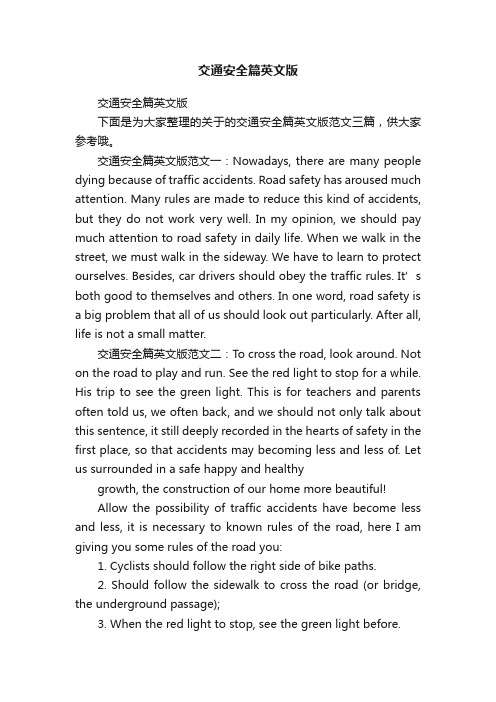
交通安全篇英文版交通安全篇英文版下面是为大家整理的关于的交通安全篇英文版范文三篇,供大家参考哦。
交通安全篇英文版范文一:Nowadays, there are many people dying because of traffic accidents. Road safety has aroused much attention. Many rules are made to reduce this kind of accidents, but they do not work very well. In my opinion, we should pay much attention to road safety in daily life. When we walk in the street, we must walk in the sideway. We have to learn to protect ourselves. Besides, car d rivers should obey the traffic rules. It’s both good to themselves and others. In one word, road safety is a big problem that all of us should look out particularly. After all, life is not a small matter.交通安全篇英文版范文二:To cross the road, look around. Not on the road to play and run. See the red light to stop for a while. His trip to see the green light. This is for teachers and parents often told us, we often back, and we should not only talk about this sentence, it still deeply recorded in the hearts of safety in the first place, so that accidents may becoming less and less of. Let us surrounded in a safe happy and healthygrowth, the construction of our home more beautiful!Allow the possibility of traffic accidents have become less and less, it is necessary to known rules of the road, here I am giving you some rules of the road you:1. Cyclists should follow the right side of bike paths.2. Should follow the sidewalk to cross the road (or bridge, the underground passage);3. When the red light to stop, see the green light before.4. Take the bus after the first, not to each other, do not bit crowded.5. Within walking on the sidewalk, there is no sidewalk to walk on the roadside.6. It should be noted, when we are walking vehicles are not allowed to chase.7. Are not allowed in the vehicle suddenly crossed near.8. Not be allowed to pass through, to sit upon the sidewalk, roadway and railroad crossing guard-rails.9. Are not allowed to hold cars on the road to recover the vehicle, forced parabolic and hit cars.10. Pre-school children in the street or walk on the road, there must be led by adults.11. Allowed the railings across the road.These are our common life should be in compliance with the rules of the road, we would also like to promote in the class column on the column or exhibition, multi-paste a number of compliance with the rules of the road, not red light running and other words like a warning so that students better understand the traffic safety importance. School can also be invited to the police his uncle, the door to the students on the traffic class, so students know better to help the traffic of human beings ... ...Security related to our life, we hope parents, the flower is the future of the motherland, the motherland's future, we need to, and so we must make to comply with traffic regulations, protect our lives, but also to the safety of others. Let us follow traffic safety, to minimize traffic accidents, so traffic will never disappear. This is the call of the times!交通安全篇英文版范文三:The traffic problem is one of the most serious problems in my hometown. Recently, more andmore people have private car, but the roads are so narrow that we have to fight against the heavy traffic when we go out. Especially during the rush hours, cars and buses are unable to move. To make things worse, many people are killed in the traffic accidents. How miserable it is!For the sake of our life and security, some measures must be taken to change the present situation. In the first place, as there are a great many cars, we should control the number of private cars and vehicles and use the public transportation more often. Secondly, the government should widen the roads and build more flyovers, so as to ease the traffic pressure and reduce the traffic accidents. In addition, the undergrounds and light rails should be constructed, so that we can have more choices when going out and do not have to worry about the traffic jams in the future.I believe the traffic problem could be solved if we devote our actions to them.。
英语作文交通安全并翻译
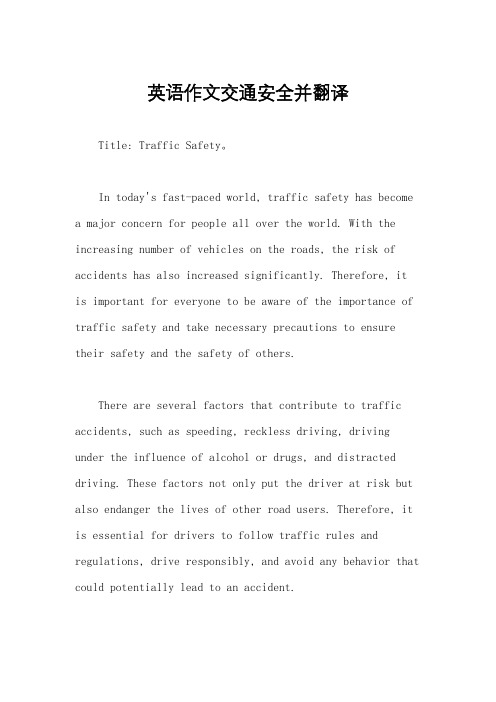
英语作文交通安全并翻译Title: Traffic Safety。
In today's fast-paced world, traffic safety has become a major concern for people all over the world. With the increasing number of vehicles on the roads, the risk of accidents has also increased significantly. Therefore, itis important for everyone to be aware of the importance of traffic safety and take necessary precautions to ensure their safety and the safety of others.There are several factors that contribute to traffic accidents, such as speeding, reckless driving, driving under the influence of alcohol or drugs, and distracted driving. These factors not only put the driver at risk but also endanger the lives of other road users. Therefore, it is essential for drivers to follow traffic rules and regulations, drive responsibly, and avoid any behavior that could potentially lead to an accident.One of the most common causes of traffic accidents is speeding. Driving at high speeds reduces the driver's reaction time and increases the likelihood of a collision. Therefore, it is important for drivers to obey speed limits and drive at a safe and reasonable speed. By doing so, they can reduce the risk of accidents and ensure their safetyand the safety of others on the road.Another major factor that contributes to traffic accidents is reckless driving. This includes behaviors such as weaving in and out of traffic, tailgating, and running red lights. Reckless driving not only endangers the driver but also puts other road users at risk. Therefore, it is important for drivers to drive defensively, stay alert, and avoid any aggressive or reckless behavior while behind the wheel.Driving under the influence of alcohol or drugs is another major cause of traffic accidents. Alcohol and drugs impair a driver's judgment, coordination, and reaction time, making it dangerous to operate a vehicle. Therefore, it is important for drivers to never drink and drive or use drugsbefore getting behind the wheel. By doing so, they can prevent accidents and save lives.Distracted driving is also a leading cause of traffic accidents. This includes activities such as texting,talking on the phone, eating, and adjusting the radio while driving. These distractions take the driver's attention away from the road and increase the risk of an accident. Therefore, it is important for drivers to focus on the task at hand and avoid any distractions while driving.In conclusion, traffic safety is a crucial issue that affects everyone on the road. By following traffic rules and regulations, driving responsibly, and avoiding dangerous behaviors, we can all contribute to making the roads safer for everyone. Remember, safety should always be the top priority when driving. Let's all work together to ensure that our roads are safe for all road users. 。
交通安全作文英语英汉互译
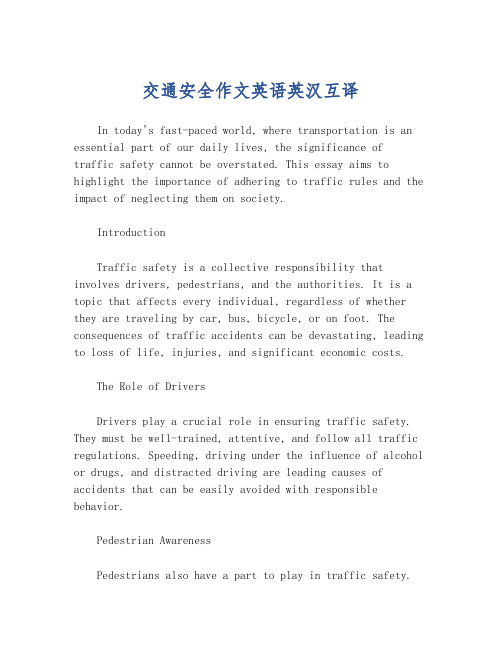
交通安全作文英语英汉互译In today's fast-paced world, where transportation is an essential part of our daily lives, the significance oftraffic safety cannot be overstated. This essay aims to highlight the importance of adhering to traffic rules and the impact of neglecting them on society.IntroductionTraffic safety is a collective responsibility that involves drivers, pedestrians, and the authorities. It is a topic that affects every individual, regardless of whether they are traveling by car, bus, bicycle, or on foot. The consequences of traffic accidents can be devastating, leading to loss of life, injuries, and significant economic costs.The Role of DriversDrivers play a crucial role in ensuring traffic safety. They must be well-trained, attentive, and follow all traffic regulations. Speeding, driving under the influence of alcohol or drugs, and distracted driving are leading causes of accidents that can be easily avoided with responsible behavior.Pedestrian AwarenessPedestrians also have a part to play in traffic safety.They should use designated crosswalks, obey traffic signals, and remain vigilant of their surroundings. Wearing bright or reflective clothing can also make them more visible to drivers, especially in low-light conditions.The Importance of InfrastructureWell-designed roads and traffic infrastructure significantly contribute to safety. This includes clear road markings, traffic signs, and signals that are easy to understand. Authorities should also ensure regular maintenance to prevent accidents caused by poor road conditions.Education and Public AwarenessRaising public awareness about traffic safety is vital. Educational campaigns can inform the public about the dangers of reckless driving and the importance of safe practices. Schools can play a role by incorporating traffic safety education into their curriculum.Technological InnovationsAdvancements in technology offer new ways to enhance traffic safety. For example, intelligent transport systems can monitor traffic flow and alert drivers to potential hazards. Vehicles are also being equipped with safety features like collision avoidance systems and automatic emergency braking.ConclusionIn conclusion, traffic safety is a multifaceted issuethat requires the commitment of everyone involved in the transportation system. By working together, we can create a safer environment for all road users and significantly reduce the incidence of traffic accidents.在当今快节奏的世界中,交通是我们日常生活中不可或缺的一部分,遵守交通规则的重要性不言而喻。
交通安全的英语作文带翻译
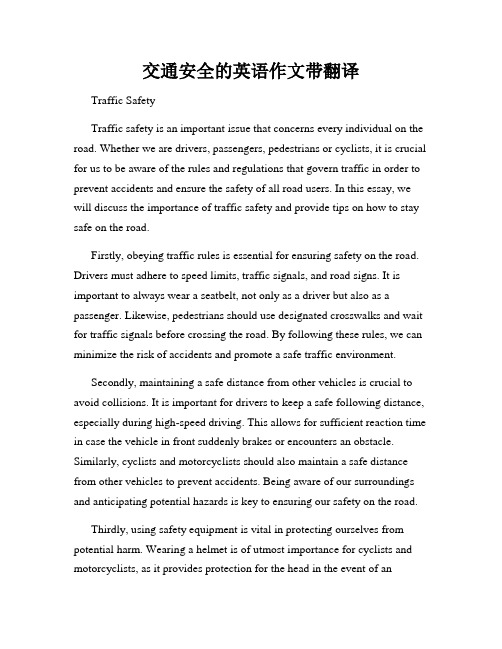
交通安全的英语作文带翻译Traffic SafetyTraffic safety is an important issue that concerns every individual on the road. Whether we are drivers, passengers, pedestrians or cyclists, it is crucial for us to be aware of the rules and regulations that govern traffic in order to prevent accidents and ensure the safety of all road users. In this essay, we will discuss the importance of traffic safety and provide tips on how to stay safe on the road.Firstly, obeying traffic rules is essential for ensuring safety on the road. Drivers must adhere to speed limits, traffic signals, and road signs. It is important to always wear a seatbelt, not only as a driver but also as a passenger. Likewise, pedestrians should use designated crosswalks and wait for traffic signals before crossing the road. By following these rules, we can minimize the risk of accidents and promote a safe traffic environment.Secondly, maintaining a safe distance from other vehicles is crucial to avoid collisions. It is important for drivers to keep a safe following distance, especially during high-speed driving. This allows for sufficient reaction time in case the vehicle in front suddenly brakes or encounters an obstacle. Similarly, cyclists and motorcyclists should also maintain a safe distance from other vehicles to prevent accidents. Being aware of our surroundings and anticipating potential hazards is key to ensuring our safety on the road.Thirdly, using safety equipment is vital in protecting ourselves from potential harm. Wearing a helmet is of utmost importance for cyclists and motorcyclists, as it provides protection for the head in the event of anaccident. Additionally, using reflective clothing or accessories when walking or cycling at night increases visibility and reduces the risk of collisions. Safety equipment such as seatbelts, airbags, and child car seats should always be properly used and maintained in vehicles to ensure maximum safety for all occupants.Furthermore, distractions while driving pose a significant risk to traffic safety. Texting, talking on the phone, or engaging in any form of distracted driving diverts attention from the road and increases the likelihood of accidents. It is crucial to focus solely on driving and avoid any distractions. Passengers should also refrain from distracting the driver and instead assist in maintaining a safe driving environment.Lastly, education and public awareness play a vital role in improving traffic safety. Promoting traffic safety campaigns, organizing workshops, and incorporating traffic safety education in school curriculums can help raise awareness and educate individuals on the importance of traffic safety. Moreover, stricter enforcement of traffic laws can serve as a deterrent and encourage compliance with traffic regulations.维护交通安全是一件关系每位道路使用者的重要事情。
交通安全英语作文 带翻译
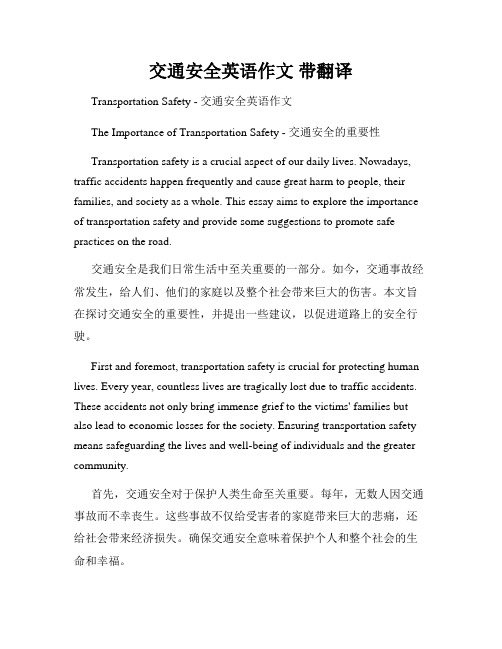
交通安全英语作文带翻译Transportation Safety - 交通安全英语作文The Importance of Transportation Safety - 交通安全的重要性Transportation safety is a crucial aspect of our daily lives. Nowadays, traffic accidents happen frequently and cause great harm to people, their families, and society as a whole. This essay aims to explore the importance of transportation safety and provide some suggestions to promote safe practices on the road.交通安全是我们日常生活中至关重要的一部分。
如今,交通事故经常发生,给人们、他们的家庭以及整个社会带来巨大的伤害。
本文旨在探讨交通安全的重要性,并提出一些建议,以促进道路上的安全行驶。
First and foremost, transportation safety is crucial for protecting human lives. Every year, countless lives are tragically lost due to traffic accidents. These accidents not only bring immense grief to the victims' families but also lead to economic losses for the society. Ensuring transportation safety means safeguarding the lives and well-being of individuals and the greater community.首先,交通安全对于保护人类生命至关重要。
交通安全的英语作文加翻译
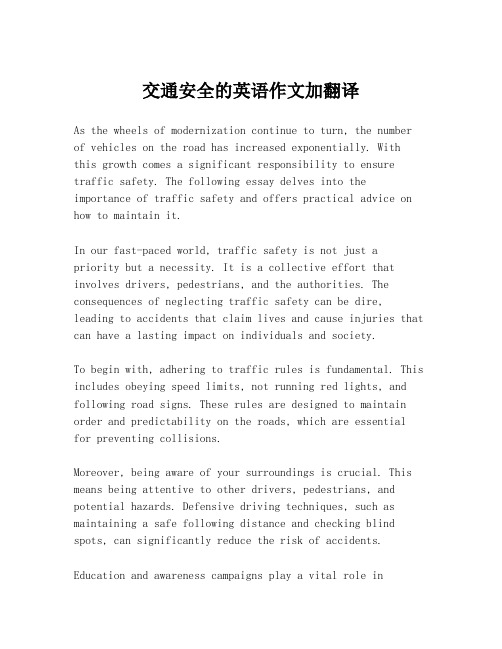
交通安全的英语作文加翻译As the wheels of modernization continue to turn, the number of vehicles on the road has increased exponentially. Withthis growth comes a significant responsibility to ensure traffic safety. The following essay delves into the importance of traffic safety and offers practical advice on how to maintain it.In our fast-paced world, traffic safety is not just apriority but a necessity. It is a collective effort that involves drivers, pedestrians, and the authorities. The consequences of neglecting traffic safety can be dire, leading to accidents that claim lives and cause injuries that can have a lasting impact on individuals and society.To begin with, adhering to traffic rules is fundamental. This includes obeying speed limits, not running red lights, and following road signs. These rules are designed to maintain order and predictability on the roads, which are essentialfor preventing collisions.Moreover, being aware of your surroundings is crucial. This means being attentive to other drivers, pedestrians, and potential hazards. Defensive driving techniques, such as maintaining a safe following distance and checking blind spots, can significantly reduce the risk of accidents.Education and awareness campaigns play a vital role inpromoting traffic safety. By informing the public about the risks and the importance of safe driving practices, we can create a culture of responsibility and respect for traffic laws.Technology also offers promising solutions to enhance traffic safety. Innovations such as intelligent traffic systems, advanced driver-assistance systems (ADAS), and even autonomous vehicles are being developed to reduce human error, which is a leading cause of accidents.In conclusion, traffic safety is a shared responsibility that requires vigilance, education, and the adoption of smart technologies. By working together, we can create safer roads for everyone.翻译:随着现代化车轮的不断转动,道路上的车辆数量呈指数级增长。
关于交通安全英语作文带翻译
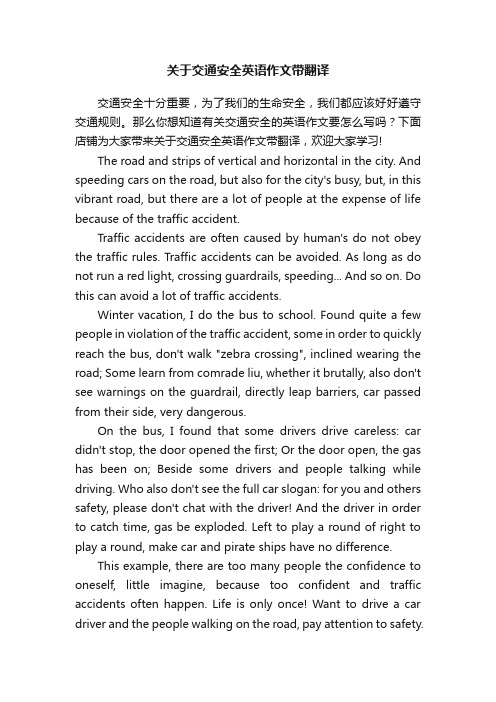
关于交通安全英语作文带翻译交通安全十分重要,为了我们的生命安全,我们都应该好好遵守交通规则。
那么你想知道有关交通安全的英语作文要怎么写吗?下面店铺为大家带来关于交通安全英语作文带翻译,欢迎大家学习!The road and strips of vertical and horizontal in the city. And speeding cars on the road, but also for the city's busy, but, in this vibrant road, but there are a lot of people at the expense of life because of the traffic accident.Traffic accidents are often caused by human's do not obey the traffic rules. Traffic accidents can be avoided. As long as do not run a red light, crossing guardrails, speeding... And so on. Do this can avoid a lot of traffic accidents.Winter vacation, I do the bus to school. Found quite a few people in violation of the traffic accident, some in order to quickly reach the bus, don't walk "zebra crossing", inclined wearing the road; Some learn from comrade liu, whether it brutally, also don't see warnings on the guardrail, directly leap barriers, car passed from their side, very dangerous.On the bus, I found that some drivers drive careless: car didn't stop, the door opened the first; Or the door open, the gas has been on; Beside some drivers and people talking while driving. Who also don't see the full car slogan: for you and others safety, please don't chat with the driver! And the driver in order to catch time, gas be exploded. Left to play a round of right to play a round, make car and pirate ships have no difference.This example, there are too many people the confidence to oneself, little imagine, because too confident and traffic accidents often happen. Life is only once! Want to drive a car driver and the people walking on the road, pay attention to safety.Because life is more important than mount tai.马路,一条条的纵横在城市中。
道路安全作文英文
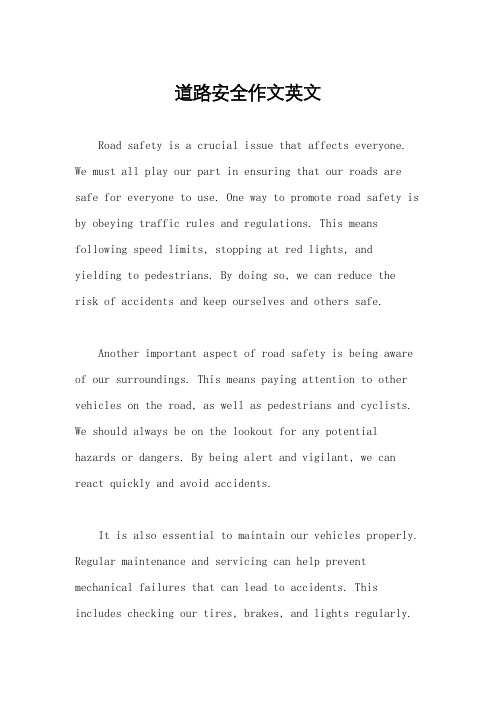
道路安全作文英文Road safety is a crucial issue that affects everyone. We must all play our part in ensuring that our roads are safe for everyone to use. One way to promote road safety is by obeying traffic rules and regulations. This means following speed limits, stopping at red lights, andyielding to pedestrians. By doing so, we can reduce therisk of accidents and keep ourselves and others safe.Another important aspect of road safety is being aware of our surroundings. This means paying attention to other vehicles on the road, as well as pedestrians and cyclists. We should always be on the lookout for any potential hazards or dangers. By being alert and vigilant, we can react quickly and avoid accidents.It is also essential to maintain our vehicles properly. Regular maintenance and servicing can help prevent mechanical failures that can lead to accidents. This includes checking our tires, brakes, and lights regularly.By ensuring that our vehicles are in good condition, we can reduce the risk of accidents caused by mechanical failures.In addition to obeying traffic rules and maintaining our vehicles, it is crucial to avoid distracted driving. This means avoiding activities such as texting, talking on the phone, or eating while driving. These distractions can take our attention away from the road and increase the risk of accidents. By focusing solely on driving, we can reduce the chances of being involved in a collision.Another important aspect of road safety is wearing seat belts. Seat belts are designed to protect us in the event of a crash and can significantly reduce the risk of serious injuries or fatalities. It is essential to make it a habit to buckle up every time we get into a vehicle, whether we are the driver or a passenger.Lastly, it is crucial to never drink and drive. Driving under the influence of alcohol or drugs is not only illegal but also extremely dangerous. It impairs our judgment, coordination, and reaction time, making it difficult todrive safely. If we plan on drinking, it is important to always have a designated driver or use alternative means of transportation.In conclusion, road safety is a collective responsibility. By obeying traffic rules, being aware of our surroundings, maintaining our vehicles, avoiding distractions, wearing seat belts, and never drinking and driving, we can contribute to creating safer roads for everyone. Let's all do our part and prioritize road safety.。
- 1、下载文档前请自行甄别文档内容的完整性,平台不提供额外的编辑、内容补充、找答案等附加服务。
- 2、"仅部分预览"的文档,不可在线预览部分如存在完整性等问题,可反馈申请退款(可完整预览的文档不适用该条件!)。
- 3、如文档侵犯您的权益,请联系客服反馈,我们会尽快为您处理(人工客服工作时间:9:00-18:30)。
Vision Zero – Implementing a policy for traffic safety The scope of this paper is to outline, in a general way, the safety philosophy inherent in present road- and street design, trace the origin of this philosophy, and to present the principles for a new design of streets and roads. It will be argued that deficiencies in the present road design philosophy are the main cause of the global road safety crisis, clearly indicating its man-made nature. A brief description is made of the decision process leading to the establishment of Vision Zero as Sweden’s Traffic Safety Policy in 1997.Following an analysis of the problem, suggestions are made for finding solutions. The solutions are based on some of the principles in Vision Zero. They include a new basic mechanism for creating error-tolerance in the road system, and new design principles for road- and street design.The tradition of “blaming the victim” is hereby questioned and focus is put on the need for professionals to act based on these new standards. During the last 10 years the fatalities in Sweden have dropped from approximately 550/year to 450/year. Roads redesigned with median barriers have an 80% reduction in fatalities. Streets with 30 km/h design speed show similar results. This indicates that measures derived from Vision Zero strategy are effective but that large scale implementation has not yet been done.1. The processThe Swedish Road Administration (SRA) had an overall responsibility for Road Traffic Safety in Sweden since 1993. This responsibility was further clarified by the Government in 1996. Sweden has very small Ministries (number of personnel). As a consequence Administrations like the SRA often have semi-political tasks like development of policies and targets. Decisions on policy, long term targets and overall budgets are made by the Government or the Parliament but development is made in the Administration.Following the elections in the autumn 1994 Sweden got a new Minister for Transportation. The Minister declared that traffic safety would be one of her priorities. A dialog was started between the Minister’s Staff and the SRA on how the Minister could make traffic safety a prioritized subject.In the spring of 1994 the SRA together with the major stakeholders for traffic safety had presented a short term program for action for theyears of 1994–2000. It had the character of continuing earlier work but with more emphasis on cooperation between key actors and focus on results. Directly after this program was launched the SRA started to develop some basic ideas for a long term strategy for traffic safety. It had been recognised for some time that the contemporary traffic safety paradigm had some problems (Johansson, 1991). Part of this problem was a lack of expected benefits of many measures, something that was recognised by among others Gerald Wilde (best described in Wilde, 2001). A comprehensive overview can be found in OECD (1990).The new safety paradigm, Vision Zero is built around the basic idea that even if not all crashes or collisions can be avoided, all severe injuries can, in principle, be avoided. The basic idea was to build a “safe system” where all predicted crashes and collisions had tolerable health losses. The Minister and her Staff recognised that it was possible to work with the ideas behind Vision Zero in a political setting and quickly adopted the basic ideas, developed a text (translated in Belin et al., 1997), and took it to the Parliament in 1997, where it was accepted by all political parties (Tingvall, 1998). Since then, the Parliament has repeated this decision on a number of occasions. The notion of “Vision Zero” has become synonymous with the concept of “high political ambitions” in a number of other areas as well. The Government in 2008 took a decision on a Vision Zero for suicide. Much of the political debate on Vision Zero between 1995 and the Parliament’s decision in 1997 was concentrated on the question”How many fatalities can we accept” At this time Sweden had around 500 fatalities in road traffic per year. Comparisons where made with the safety level for other transport modes, (clearly a zero fatality goal), occupational safety (about 50 fatalities annually), electricity (about five fatalities annually). From this political analysis it was concluded that a zero fatality target was the only justifiable target for road traffic.During the same time period SRA and its network concentrated work on developing strategies for radically lowering fatality risks in road traffic, typically aiming at reducing fatality risks with a factor 10. Examples follow later in this paper.2. Vision ZeroIn 1997 the Swedish Parliament passed a bill on Traffic Safety where it was stated that:“Vision Zero means that eventually no one will be killed orseriously injured within the r oad transport system.”Vision Zero does not presume that all accidents that result in personal property damage or in less serious injuries must be eliminated. These occurrences are not considered to be an essential element in the road traffic safety problem even if they can entail large costs for the State, county councils, municipalities and individuals. Rather, focus shall be placed on those incidents that lead to a person being killed or seriously injured. Vision Zero also proposes an ethical approach to the health problems associated with road traffic:“It can never be ethically acceptable that people are killed or seriously injured when moving within the road transport system.”Vision Zero is said to be a long-term goal for the design and functioning of the road transport system. What is important is to realise that the Vision Zero approach will alter the aim of the work on road traffic safety; ., from attempting to reduce the number of accidents to the formulation of an explicit goal: to eliminate the risk of chronic health impairment caused by a traffic accident. This new approach will also alter the question from “what can we do” to “what must we do”Vision Zero presumes a new division of responsibility for road traffic safety within the road transport system. The responsibility for road traffic safety should be introduced along the following lines.1. The designers of the system are always ultimately responsible for the design, operations and use of the road transport system and are thereby responsible for the level of safety within the entire system.2. Road users are responsible for following the rules for using the road transport system set by the system designers.3. If road users fail to obey these rules due to a lack of knowledge, acceptance or ability, or if injuries do occur, the system designers are required to take the necessary further steps to counteract people being killed and seriously injured.Taking the Vision Zero approach means that paying attention to human life and health is an absolute requirement in the design and functioning of the road transport system. This implies that road traffic safety issues, in similarity to environmental issues, must be clearly integrated in all the processes that affect road traffic safety in the road transport system and be based on the following:“The level of violence that the human body can tolerate without being killed or seriously injured shall be the basic parameter in the designof the road transport system.”It is upon this principle that the future society with safe road traffic can develop: through designing and constructing roads, vehicles and transport services so that the level of violence that can be tolerated by the human being is not exceeded; and through the effective contribution of different support systems such as rules and regulations, education, information, surveillance, rescue services, care and rehabilitation. With this as the basis, there will be a positive demand for new and effective solutions that can contribute to a road transport system where human needs, prerequisites and demands are in focus.“It is true, that 95% of all crashes or collisions depend on human error, but according to Vision Zero philosophy, 95% of the solutions are in changing roads, streets or vehicles.”Some simple examples follow:(1) Drivers in Sweden used to have a 92% seat-belt wearing rate. Good but not good enough. EuroNCaP1 established a protocol for seat-belt reminders a couple of years ago having the effect that 70% of new cars sold in Sweden 2005 had seat-belt reminders. The drivers of these cars have a seat-belt wearing rate of 99%. Hence, the problem of seat-belt wearing will gradually be solved at a very low cost.(2) Alcohol: All over the world alcohol and traffic is a big problem, even if improvements can be made with strict legislation and enforcement. By demonstrating a demand for safe transport primarily by professional transporters a demand for “proven sober” transports has risen. In Sweden about 50% of all school buses have alcohol interlocks (a device that checks if the driver is sober). A new generation of Alco locks are coming on the market (at least four competitors in Europe/USA) reducing price and improving performance.In this way a car that reminds you to use your seat-belt, and checks your breath for alcohol, or otherwise checks your performance, and assists you to be a better, safer driver. Different aspects of the Vision Zero philosophy can be found in (Tingvall et al., 1996, 1997; Tingvall, 1998, 2007; Belin et al., 1997).3. Traditional road design philosophyThe traditional road-oriented safety philosophy has as its starting point the ‘‘accident”. Accident statistics are normally based on police reports made up on traffic accidents known to the police. These statistics have been used by road authorities world-wide for describing and analysing the road safety problem associated with roads and roaddesign. It is important to notice that the conceptsof traffic accidents and (bad) road safety are not synonymous. Many accidents could be an indicator of (bad) safety, but if the accidents do not lead to personal injuries they are not. Road safety is a ‘loss of health’ problem. A crash or accident without loss of health is no safety problem, only a cost. But the thesis put forward in this paper is another, namely that by choosing the ‘‘accident” perspective, you get a safety philosophy that at its best reduces accidents, not necessarily personal injuries. And, as all modern definitions of the traffic safety problem define it as a health problem (health loss) the accident perspective misses the target.Accident analysis shows typically that 90–95% of all accidents are caused by road users. Society’s most fundamental response to accident prevention has been rules and regulations for road user behaviour. The purpose of traffic legislation is mainly to simplify the tasks for road users, making the risk of accident lower. In many cases this works as intended. But if focus is shifted to the effect of the traffic regulation on health loss, the pattern is less clear. Examples could be, for instance, traffic lights and pedestrian crossings. Installing traffic lights typically results in fewer crashes, but more severe injuries. Pedestrian crossings generally do not lead to a safer crossing for pedestrians; they facilitate crossing a street but provide no safety in themselves.When it comes to road- and street design the dominant safety strategy overall has been to increase space for drivers and vehicles. That is, wider lanes, wider roads, straighter roads, larger crossings etc. The reasoning behind this is straightforward and logical; if drivers run off the road, make the road a little bit wider so there is room for manoeuvring the vehicle back into the lane and keeping the vehicle on the road; if drivers run off the road in bends, try making the road a little bit straighter thereby avoiding accidents in bends. This strategy has had some success in reducing the number of accidents, but even the effect on the accident risk has been questioned (Hauer, 1999). The strategy to create space for evasive action has not been successful in reducing fatalities and other severe injuries. In fact, everything else considered, this strategy increases fatalities and other health losses. A wide, strait road has more fatalities than a narrow road with many curves if everything else is the same. The reason is simple: the most predominant effect of creating more space is an increase in driving speed, which means higher levels of kinetic energy in crashes. Higher energy levels lead to more severe health losses,all other things being equal. This increase in speed has two reasons; first road administrations normally set a higher speed limit on roads that are wide and straight because they are said to have a higher safety standard, and drivers tend to drive faster anyway on these roads.This safety philosophy to build wide, straight roads and streets is one of the main contributions to the present global road safety crisis. The result is an increase, by one or two factors of 10, in the risks of severe personal injury or fatality, compared to the Vision Zero design philosophy described later in this paper. No other design parameter has an impact of this magnitude. As an example Swedish 2-lane highways with a speed limit of 110 km/h had one of the most severe injury pattern recorded ever; out of three persons injured on these roads, one was killed. Relatively new Chinese highways produce more than 1 killed/km/year. The main difference between the Swedish rural roads and the Chinese highways is that the latter have a large quantity of vulnerable road users, who are ‘‘separated” from motorised vehicles only by the“wideness” of the roads and traffic regulations . pedestrian crossings. It has been shown on the Swedish roads mentioned in the example that the fatalities can be reduced by 85–90% by applying mid- and side barriers. The Chinese highways mentioned above could, at least in principle, be rebuilt reducing fatalities with up to 99%.A note must be made on motorisation and its effect on overall safety in a country. Sweden has approximately cars/inhabitant whereas China is only in its beginning as a motorised country with cars/inhabitant. The World Bank has noted that the number of persons killed in a country turns from an increasing trend to a decreasing trend when the GNP/capita reaches approximately 8000 US$ (Kopits and Kropper, 2003). A hypothesis based on this data could be that the change in composition of traffic, that is, the mixture of protected/unprotected road users reaches a critical limit at that stage of economic development. That is, the separation between vehicles and unprotected road users reaches a certain level which has an overall good effect on road safety. It should also be noted that this separation in (most) societies is spontaneous and not engineered. It is a function of more and more people becoming motorised (car or bus) and the number of vulnerable road users decreasing, especially on rural roads. The challenge in a developing country is of course to engineer this separation at an early stage of motorisation.4. Design principles in Vision ZeroThe human tolerance for biomechanical forces is in this perspective the starting point for the design of a safe traffic system. This tolerance is a given factor –it cannot be affected to any significant extent. For instance if cars hits pedestrians at 25–30 km/h most of them survive. However, if the cars instead do 50 km/h, most pedestrians will die.The trick from an engineering point of view is to design and construct a traffic system where this human tolerance is not exceeded. Whereas the general strategy for safe road design from the accident perspective was to increase space for drivers and vehicles, the corresponding strategy from a Vision Zero perspective is to manage kinetic energy in crashes and collisions. It is kinetic energy that kills and injures the road user –not the accident. By managing the crash in terms of the energy that is transferred to the human body, an error tolerance can be built into the traffic system. In fact, an error tolerance was also the intention behind the idea to give drivers space in the traditional safety paradigm. Space would give room for evasive manoeuvres thus avoiding the accident; the problem was that it never worked the way it was intended.The management of kinetic energy in crashes and collisions can be broken down to the following principle for road and street design; “Integration and Separation”: kinetic energy is managed by integrating compatible traffic elements and by separating incompatible ones. Here are some boundary values:1. Vulnerable road users should not be exposed to motorised vehicles at speeds exceeding 30 km/h.2. If 1. cannot be satisfied then separate or reduce the vehicle speed to 30 km/h.3. Car occupants should not be exposed to other motorised vehicles at speeds exceeding 50 km/h in 090crossings.4. If 3. cannot be satisfied then separate, or reduce the angle, or reduce the speed to 50 km/h.5. Car occupants should not be exposed to oncoming traffic (other vehicles of approximately same weight) at speeds exceeding 70 km/h or 50 km/h if oncoming vehicles are of considerably different weight.6. If 5. cannot be satisfied then separate, homogenise weights or reduce speeds to 70 (50) km/h.7. Car occupants should not be exposed to the road side at speeds exceeding 70 km/h, or 50 km/h if the road side contains trees or other narrow objects .8. If 7. cannot be satisfied separate or reduce speed to 70 (50) km/h.视觉零——道路交通安全的一项实施政策本文的范畴是一个提纲,一般来说,道路安全理念本来就存在于现在道路和道路设计中。
